Family name: Alstroemeriaceae E. Bayer
Synonym(s): Luzuriagaceae Lotsy
Common name(s): alstroemeria or Peruvian lilies family
*Number of genera/species: 4/254
List of genera records in GRIN-Global
fruit or seed
Fruit a three-valved, loculicidalloculicidal:
type of capsular dehiscence, opening longitudinally through the locules (compare septicidal)
 capsulecapsule:
capsulecapsule:
a dry, dehiscent fruit derived from a compound ovary (open explosively in Alstroemeria), rarely berrylike and mealymealy:
(open explosively in Alstroemeria), rarely berrylike and mealymealy:
loose, dry, and disintegrating in finely granular
pieces like meal or flour
(Bomarea sp.), 5–15 mm long, ovoidovoid:
3D shape—ovate to conicalconical:
to conicalconical:
3D shape—cone-shaped, with the point of attachment at the broad end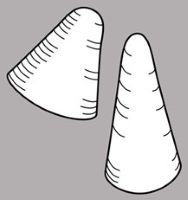 , tereteterete:
, tereteterete:
approximately circular in cross section; width and thickness approximately equal
 to angledangular:
to angledangular:
2D shape—having sides that meet at acute or obtuse angles
in transection, often beakedbeak:
a usually firm, terminal appendage, sometimes tapered , usually with many seeds. Rarely with persistent tepalstepal:
, usually with many seeds. Rarely with persistent tepalstepal:
a member of the perianth, when it cannot be differentiated into a calyx and corolla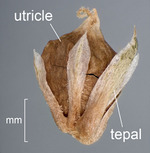 , stylestyle:
, stylestyle:
in a flower, the narrow and elongated part of the pistil between the stigma and the ovary; sometimes persisting in fruit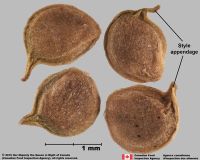 , and/or stamens. Pericarppericarp:
, and/or stamens. Pericarppericarp:
fruit wall or fruit coat
brown or brightly colored (yellow, red, orange, purple, or blue), paperypapery:
texture—papyraceous, chartaceous; very thin, pliable, and readily torn; like paper
to leatheryleathery:
texture—moderately thick, tough, and very pliable
except woodywoody:
texture—consisting mainly of indurate lignified tissues, characteristic of or resembling wood
in Bomarea, ribbedribbed:
surface relief—wide, prominent, linear ridges that are generally rounded and longitudinally situated on the surface . Seeds sometimes remain attached to the placentae.
. Seeds sometimes remain attached to the placentae.
Seeds globoseglobose:
3D shape—more or less spherical to ovoidovoid:
to ovoidovoid:
3D shape—ovate , 2–7 mm long. Thick, red, fleshy sarcotestassarcotesta:
, 2–7 mm long. Thick, red, fleshy sarcotestassarcotesta:
pulpy or fleshy outer layer of the seed coat, simulates aril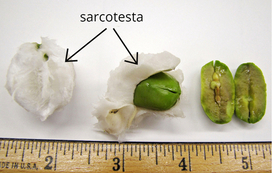 present in Bomarea. Seed coat variously colored sometimes brightly so (red, orange, or yellow), hard, granulargranular:
present in Bomarea. Seed coat variously colored sometimes brightly so (red, orange, or yellow), hard, granulargranular:
surface relief—having a grainy surface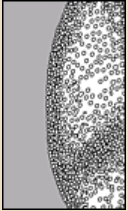 , papillatepapillate:
, papillatepapillate:
surface relief—bearing minute, distinct, broad-based projections, tapering to a rounded apex , wartywarty:
, wartywarty:
surface relief—distinct, rounded projections that are large relative to the fruit size; tuberculate, verrucose or colliculatecolliculate:
or colliculatecolliculate:
surface relief—covered with small, round projections, similar to blistered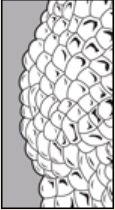 . Phytomelanphytomelan:
. Phytomelanphytomelan:
carbonaceous, opaque material that usually covers the seed coat to give it a black appearance, common in certain monocot families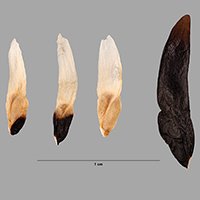 present in some genera. In Alstroemeria and Bomarea, a dark brown discoiddiscoid:
present in some genera. In Alstroemeria and Bomarea, a dark brown discoiddiscoid:
3D shape—resembling a disc
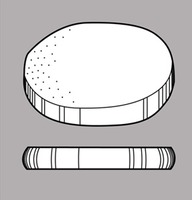 appendage is attached at the chalazalchalaza:
appendage is attached at the chalazalchalaza:
the region at the base of the ovule where the integuments are inserted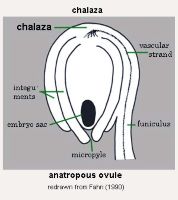 end of the seed.
end of the seed.
Embryo well developed, linearlinear:
(shape) long, narrow, and uniform in width; (of embryo) embryo is straight and much longer than wide , straight, or curvedcurved:
, straight, or curvedcurved:
(of embryo) linear embryo is curved into an arch or horseshoe with the ends far apart .
.
Endosperm copious.
| Fruit | |
| Type | loculicidalloculicidal: type of capsular dehiscence, opening longitudinally through the locules (compare septicidal)  capsulecapsule: capsulecapsule:a dry, dehiscent fruit derived from a compound ovary  , rarely a berryberry: , rarely a berryberry:an indehiscent, fleshy fruit with one or a few to many seeds. The flesh may be homogenous throughout. Or, if the outer part is hard, firm, or leathery, referred to as an hesperidium. Septa are present in some, and the seeds may be arillate or with a fleshy testa. 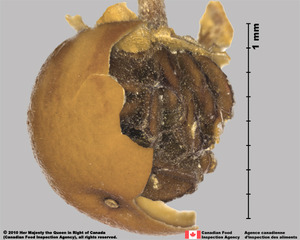 |
| Size range | 5–15 mm long |
| Shape(s) | ovoidovoid: 3D shape—ovate  , conicalconical: , conicalconical:3D shape—cone-shaped, with the point of attachment at the broad end  |
| Texture | leatheryleathery: texture—moderately thick, tough, and very pliable , spongyspongy: soft, light, discontinuous but cohesive, and somewhat resilient , paperypapery: texture—papyraceous, chartaceous; very thin, pliable, and readily torn; like paper , woodywoody: texture—consisting mainly of indurate lignified tissues, characteristic of or resembling wood |
| Surface relief | ribbedribbed: surface relief—wide, prominent, linear ridges that are generally rounded and longitudinally situated on the surface  |
| Color(s) | yellow, red, orange, brown, blue, purple |
| Unique features | Often brightly colored, ribbedribbed: surface relief—wide, prominent, linear ridges that are generally rounded and longitudinally situated on the surface  , capsulescapsule: , capsulescapsule:a dry, dehiscent fruit derived from a compound ovary  , sometimes with seeds attached to placentaplacenta: , sometimes with seeds attached to placentaplacenta:surface of the ovary that bears ovules at maturity. |
| Seed | |
| Size range | 2–7 mm long |
| Shape(s) | globoseglobose: 3D shape—more or less spherical  , ellipsoidellipsoid: , ellipsoidellipsoid:3D shape—elliptic , ovoidovoid: 3D shape—ovate  |
| Surface relief | granulargranular: surface relief—having a grainy surface  , papillatepapillate: , papillatepapillate:surface relief—bearing minute, distinct, broad-based projections, tapering to a rounded apex  , wartywarty: , wartywarty:surface relief—distinct, rounded projections that are large relative to the fruit size; tuberculate, verrucose  , colliculatecolliculate: , colliculatecolliculate:surface relief—covered with small, round projections, similar to blistered  |
| Color(s) | brown, yellow, yellowish brown, red, orange, black |
| Unique features | Fleshy, red sarcotestasarcotesta: pulpy or fleshy outer layer of the seed coat, simulates aril  present in Bomarea; phytomelanphytomelan: present in Bomarea; phytomelanphytomelan:carbonaceous, opaque material that usually covers the seed coat to give it a black appearance, common in certain monocot families  present in some genera. present in some genera. |
| Other | |
| Embryo | well developed, linearlinear: (shape) long, narrow, and uniform in width; (of embryo) embryo is straight and much longer than wide  , straight or curvedcurved: , straight or curvedcurved:(of embryo) linear embryo is curved into an arch or horseshoe with the ends far apart  |
| Nutritive tissue | endosperm copious |
Central and South America, including the West Indies, and Australia and the Pacific Islands.
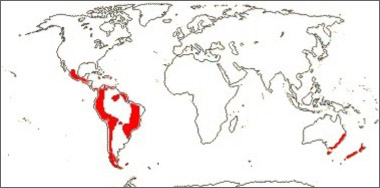
Distribution map courtesy of Angiosperm Phylogeny Website.
Baskin and Baskin 2021Baskin and Baskin 2021:
Baskin C and Baskin J. 2021. Relationship of the lateral embryo (in grasses) to other monocot embryos: A status up-grade. Seed Science Research 31 (3): 199-210. doi:10.1017/S0960258521000209; Dahlgren et al. 1985Dahlgren et al. 1985:
Dahlgren RMT, Clifford HT, and Yeo PF. 1985. The families of the monocotyledons: structure, evolution, and taxonomy. Springer-Verlag, Berlin. 520 pp.; Flora of Australia 2021+Flora of Australia 2021+:
Flora of Australia. Australian Biological Resources Study, Canberra. Accessed January 2021–March 2024. URL: http://www.ausflora.org.au; Kirkbride et al. 2006Kirkbride et al. 2006:
Kirkbride JH, Jr, Gunn CR, and Dallwitz MJ. 2006. Family guide for fruits and seeds, vers. 1.0. Accessed September 2020-January 2022. URL: https://nt.ars-grin.gov/seedsfruits/keys/frsdfam/index.cfm .; Kubitzki et al. 1990+Kubitzki et al. 1990+:
Kubitzki K et al., eds. 1990+. The families and genera of vascular plants. 7+ vols. Berlin etc.; Sanso and Xifreda 2001Sanso and Xifreda 2001:
Sanso AM and Xifreda CC. 2001. Generic delimitation between Alstroemeria and Bomarea (Alstroemeriaceae). Annals of Botany 88 (6): 1057-1069. http://dx.doi.org/10.1006/anbo.2001.1548; Stevenson and Loconte 1995Stevenson and Loconte 1995:
Stevenson DW and Loconte H. 1995. A cladistic analysis of monocot families. In: Rudall PJ, Cribb PJ, Cutler DF, and Humphries CJ, eds. Monocotyledons: Systematics and Evolution. Royal Botanic Gardens, Kew.; Takhtajan 2009Takhtajan 2009:
Takhtajan A. 2009. Flowering plants: Second edition. Springer Nature, Switzerland. 871 pp.; Watson and Dallwitz 1992+Watson and Dallwitz 1992+:
Watson L and Dallwitz MJ. 1992+. The families of flowering plants: descriptions, illustrations, identification, and information retrieval. Version: 6th Accessed September 2020-September 2022. URL: delta-intkey.com
*The number of genera and species is based on Christenhusz and Byng 2016Christenhusz and Byng 2016:
Christenhusz MJM and Byng JW. 2016. The number of known plant species in the world and its annual increase. Phytotaxa 261 (3): 201-217. https://doi.org/10.11646/phytotaxa.261.3.1, which may differ from the number of genera in GRIN-Global.